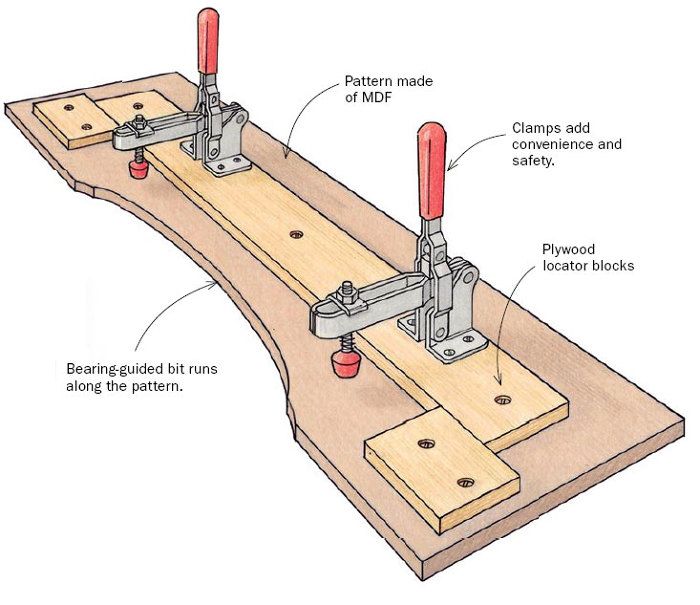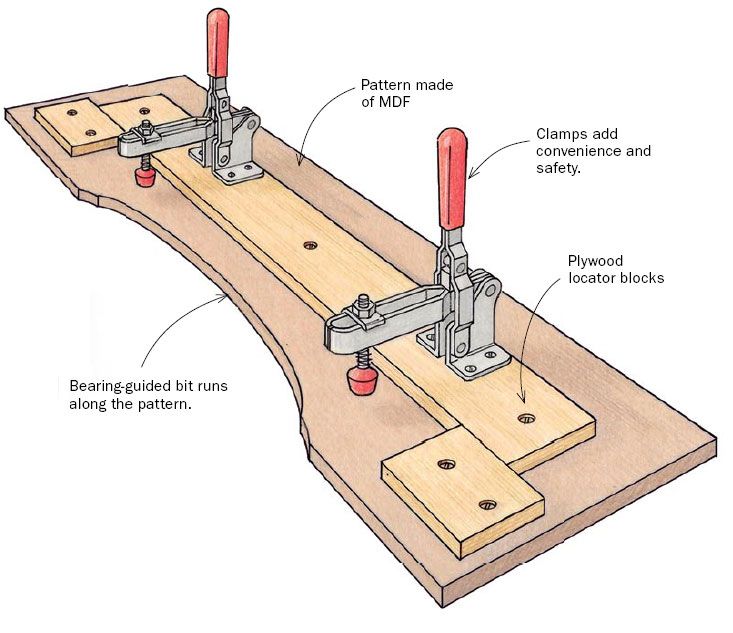Pattern-Routing Jig

Designed by Peter Schlebecker
Used with a bearing-guided flush-trimming bit, this jig makes pattern cutting as easy as possible. It’s made from a piece of medium-density fiberboard (MDF), with plywood locator blocks screwed in place to hold the workpiece tight. Toggle clamps add extra control and make convenient handholds when moving the jig past the router blade.
Watch a video on making and using this jig.
Read more about this jig and see how to make four others like it in an article by Schlebecker.



















Comments
We use similar jigs to cut tapered table legs on the bandsaw and table saw. They work.
I made this jig after seeing it in FWW. Easy to make and use - just remember to cut up the curve - as noted in video. If saved, the pattern can be and easily stored after the clamps are removed. The clamps can be reused on the next pattern you make. Works for me.
I am always surprised to see pictures of people working at router tables without using any guard above the bit. In case the bit gets damaged, you do not want be in the way of pieces of broken metal flying around in the workshop. Forget this comment, in case the guard had been removed to better show the jig.
I would prefer plywood to MDF despite higher costs, as MDF is a more 'dusty' to work with, and screws (for the clamps)hold better in plywood.
Excellent woodworker is the person that uses these jigs. I have been doing this since 1975. I run all our shapers on jigs with hold downs period. We even use jigs on straight against the fence cope and stick rail and door parts. We always use them on raised panel parts. This is the smart and safe and slow way to run them. My employees in the shop love to run my machines because of the safe feeling they get in our shop! We use/buy the orange handles with the black sponge bottoms (mainly sold for jointer facing). We get them at Woodcraft or Rockler so the operator has two large substantial hand grips and no chance of a slip of the hands as in the photo. As to the post on no guards, it is very difficult to run against a bearing cutter with any guard on the spindle. If a knife or carbide is thrown the guard won't normally slow it down or stop it, but it normally goes out the North West back side of the shaper or router and we don't let people stand behind a machine when it is running. There is no guarantee on that statement either, as woodworking has risk and danger every second you are doing it. Now we have some of the Delta clear plastic flying saucers that came with the shaper, but if your hands are on the orange hand grips, you most likely don't need any further guards. We use MDF only because it is highly refined and very smooth; plywood has voids in it since they don't make lumber core much anymore. We go through many sheets a year to make shaper jigs. We run against a starter pin and then get off it and go into the shaper bearing and cutter on a 1.25" spindle 5 HPSF machine. We make RPD parts, and many kinds of radius moldings all the time.
Seems to me not many shapers are used much any more, but it is a great machine and far superior to a router table for heavy cuts. On the MDF, we use Kreg square drive screws and 1.50" thick jigs. We screw into both with 1.25" screws. Yes we reuse the MDF, Clamps, Jigs until they are scrap. We have many clamps and gigs in storage also. I recommend the jigs 100% of the time and still have 10 fingers now.
I HAVE USED A SIMILAR JIG FOR MAKIG CURVED CABINET DOOR RAILS.
ONLY I GLUED SAND PAPER TO TOP OF JIG AND MADE A SET OF PATTERNS OF EQUAL LENGHT WITH NEEDED CURVES.
I ALSO HAVE USED DOWEL TO LOATE PATTERS ON JIG ,JUST DRILL
ALL PATTERNS THE SAME IN A STACK,THAT MAKES CHANGIG AND CENTERING EASY.
THESE PATTERNS ARE CLAMPED BETWEEN WORK PIECE AND JIG
SO ONE JIG CAN BE USED FOR A WHOLE SET OF RAIL PATTERNS.
Log in or create an account to post a comment.
Sign up Log in